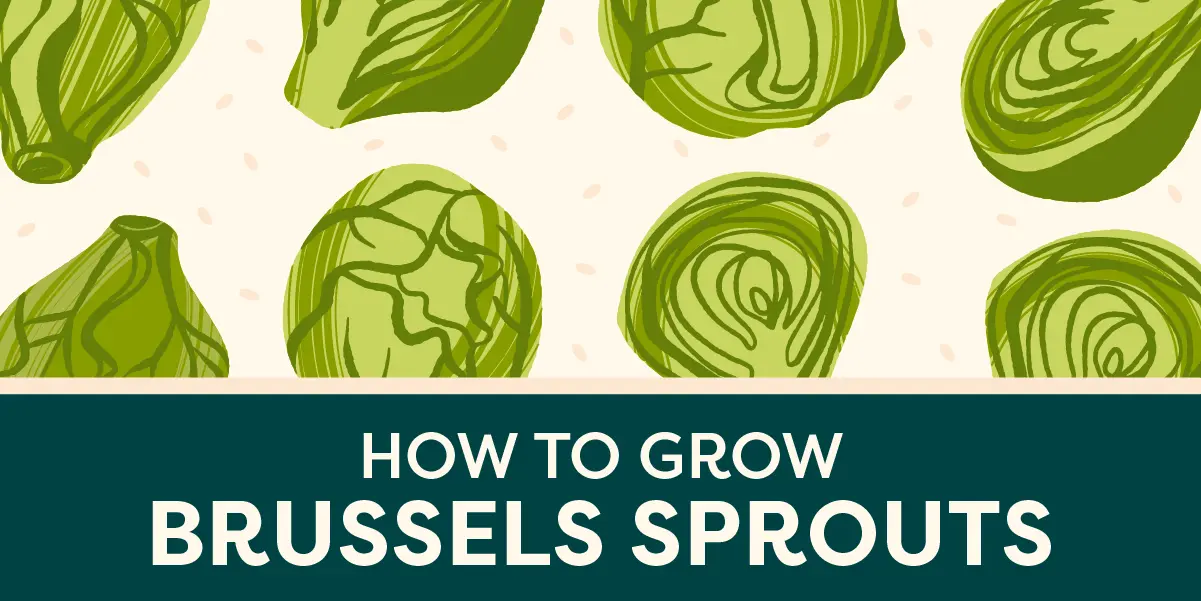Love ’em or hate ’em, there’s no denying the nutritional punch and distinct flavor of Brussels sprouts.
Glucosinolate compounds are responsible for their bitterness and intense aroma. When roasted, Brussels sprouts develop a sweet, caramelized flavor that balances out the bitterness.
These glucosinolates have anti-cancer, anti-inflammatory, anti-diabetic, and lipid-lowering properties, among others. So your mother was right, back in the day, to make you finish your plate of acrid veggies.
Brussels sprouts, along with other cabbage species, most likely originated in the Mediterranean region. By the 5th century, they were widely cultivated in Northern Europe.
The modern Brussels sprout, as we know it, was developed in Belgium in the 16th century, hence its name.
Like most cabbage family members, Brussels sprouts thrive in temperatures between 45-75°F. In Southern California, they’re typically planted in the late summer or early fall for a winter harvest, but can also be grown in the spring for an early summer crop.

A newly harvested Brussels sprouts stalk.
Best Varieties for Southern California
Brussels sprouts are classified as annuals. Once sprouts are harvested, the plants are typically removed from the garden.
However, because they can be grown over multiple seasons under the right conditions, some gardeners cultivate the same plants year after year.
These are some of the best varieties for Southern California:
- Jade Cross is known for its heat tolerance, producing small, sweet sprouts.
- Long Island Improved offers good yields and can withstand higher temperatures.
- Vigador is a hybrid variety resistant to bolting. It produces firm, uniform sprouts, perfect for longer growing seasons.
- Gourmet has a mild, nutty flavor and has been bred to adapt to varying weather conditions.
- Prince Marvel thrives in warmer climates and matures quickly, allowing for an earlier harvest.
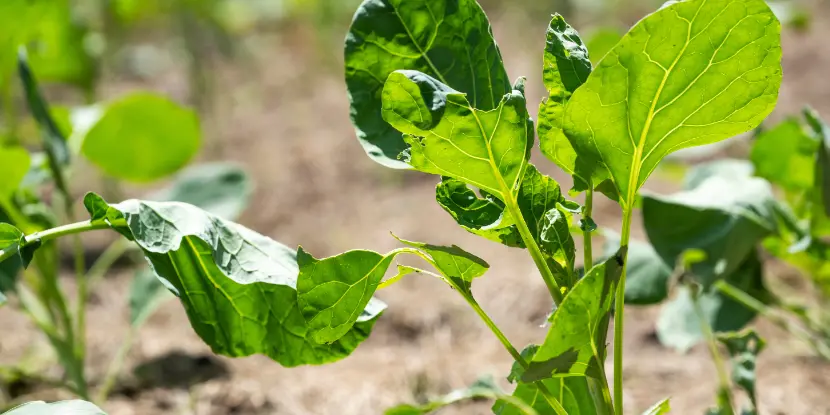
Young Brussels sprouts plants in the garden.
Choosing & Preparing Your Garden Site
- Brussels sprouts require at least six hours of sunlight per day.
- They can benefit from some light shade during the hottest parts of the day. Afternoon shade can reduce stress on the plants and the chances of bolting.
- They prefer rich, loamy soil with good drainage. Building raised garden beds elevates the soil above ground level, allowing excess water to escape more easily.
- Test your soil pH and amend it if necessary using lime to raise the pH or sulfur to lower it. The ideal pH range is between 6.0 and 7.0.
- Till the soil to a depth of at least 12 inches. This will improve aeration, drainage, and nutrient availability.
- Incorporate organic matter into the tilled soil, such as well-rotted manure or compost. This enhances soil fertility and structure.
- Clear the garden area of weeds and debris before planting. Weeds can compete for nutrients and moisture, potentially stunting your sprouts.
Planting Brussels Sprouts
- You can buy young seedlings from a nursery or sow seeds directly into the soil. If opting for seeds, start them indoors 6-8 weeks before the last expected frost.
- If planting seeds directly, sow them 1/4 to 1/2 inch deep in the soil after the danger of frost has passed, typically in late summer or early fall for a winter harvest.
- When transplanting seedlings, plant them deep enough so that the soil level is up to the first set of leaves. Space them at least 18-24 inches apart — Brussels sprouts grow tall.
- Water the plants immediately after planting to settle the soil around the roots.
- Apply a layer of organic mulch around the base of the plants to retain moisture, suppress weeds, and regulate soil temperature.
- If you sow seeds directly, thin the seedlings to ensure that only the strongest remain, allowing for enough space for each sprout to develop.
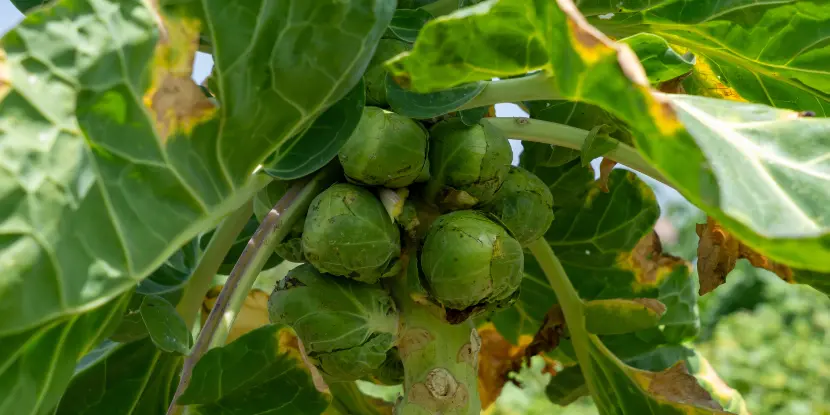
Brussels sprouts forming on the central stalk.
Caring for Your Brussels Sprouts
Watering
Brussels sprouts need regular watering, especially during dry spells. Aim to keep the soil consistently moist but not soggy.
Fertilizing
- Pre-Planting: Amend the soil with organic matter such as compost or aged manure. This will provide essential nutrients and improve soil structure.
- Initial Planting: Apply a balanced slow-release fertilizer (like a 10-10-10 NPK) according to the package instructions.
- Mid-Growth (4-6 weeks after planting): Side-dress with a nitrogen-rich fertilizer (such as ammonium nitrate) to support leafy growth. Follow the recommended dosage on the label.
- Late Growth (6-8 weeks before harvest): Apply a second dose of balanced fertilizer to promote healthy sprout development. Water well after application to help nutrients penetrate the soil.
- Final Touch (2 weeks before harvest): To ensure the best flavor and quality of the sprouts, avoid fertilizing just before harvest. Instead, focus on maintaining consistent moisture levels.
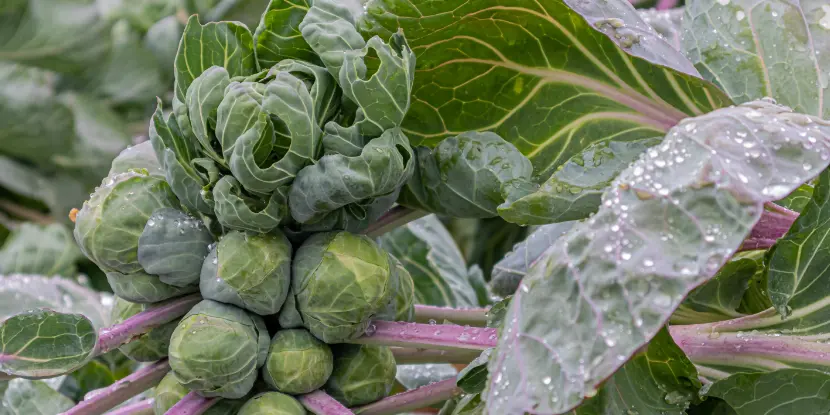
Beads of water on Brussels sprouts foliage.
Dealing with Pests & Diseases
Common Pests
- Aphids are tiny insects that suck the sap from your plants. Blast them off with a strong jet of water or use insecticidal soap.
- Cabbage Worms are caterpillars that munch on leaves. Hand-pick them or use Bt (Bacillus thuringiensis) for control.
- Flea Beetles are small, jumping beetles that create tiny holes in leaves. To deter them, use row covers or neem oil.
Common Diseases
- Downy Mildew is a fungal disease that causes yellow spots on leaves. Ensure good air circulation and avoid overhead watering.
- Clubroot is a soil-borne disease that causes swollen roots. Prevent it by rotating crops and maintaining proper soil pH.
Harvesting Your Brussels Sprouts
When to Harvest
Brussels sprouts are usually ready to harvest 80-100 days after planting. You’ll know they’re ready when:
- Sprouts are Firm: Check for tight, firm buds about 1-2 inches in diameter.
- Leaves Yellowing: Lower leaves may turn yellow as the sprouts mature.
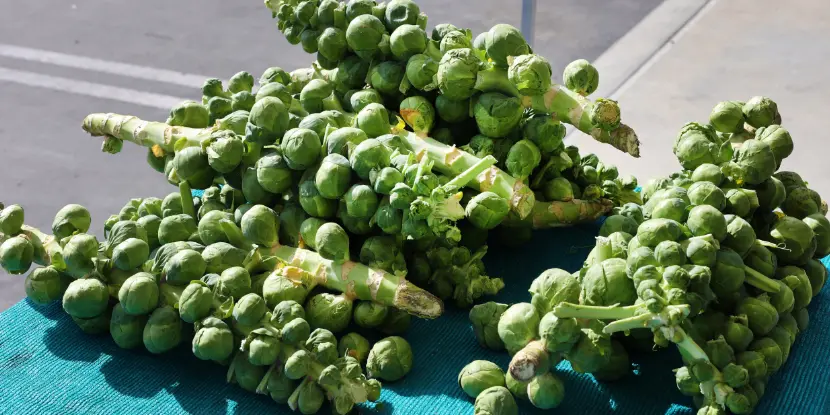
Four stalks with abundant sprouts.
How to Harvest
- Sprouts mature from the bottom up. Begin harvesting the lower sprouts first.
- Gently twist the sprouts until they snap off the stem.
- Keep picking mature sprouts to encourage further growth.
Storing Brussels Sprouts
- Store unwashed sprouts in a plastic bag in the refrigerator crisper drawer. They can last up to a week.
- To freeze, blanch sprouts in boiling water for 3-5 minutes, then plunge into ice water. Freeze them in airtight bags for up to a year.
Cooking Ideas
Now, it’s time to enjoy the fruits of your labor. Here are a few mouth-watering ways to prepare Brussels sprouts:
- Roasted: Toss with olive oil, salt, and pepper, then roast until crispy.
- Sautéed: Cook with garlic and bacon for a savory side dish.
- Steamed: Keep it simple and steam until tender, then drizzle with lemon juice.
- Grilled: Toss Brussels sprouts in olive oil, season them, and grill them on skewers for a smoky flavor.
- Stir-Fried: Add sliced Brussels sprouts to a hot wok with vegetables and sauce, cooking quickly for a flavorful dish.
- Braised: Boil them slowly in broth with herbs for a rich, comforting side.
- Pureed: Steam and blend Brussels sprouts with cream, coconut milk, or butter for a smooth and creamy soup base.
- Slaw: Shred raw Brussels sprouts and mix with vinaigrette and toppings for a crunchy salad.
- Baked in Casseroles: Combine with cheese and other vegetables in a casserole dish, baking until golden and bubbly.
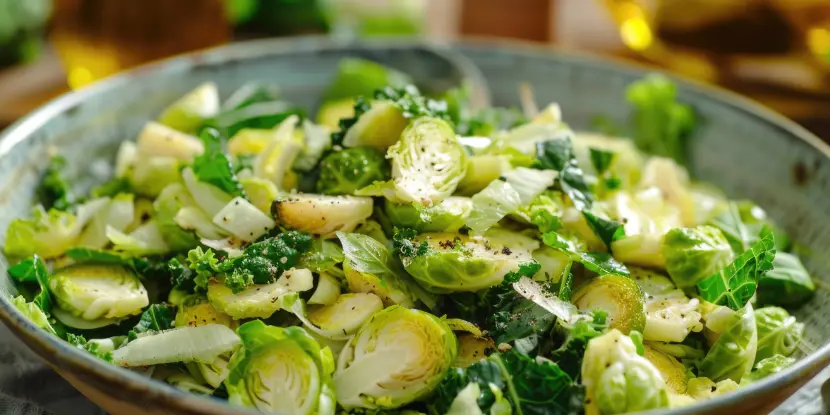
Brussels sprouts can be sautéed, shredded in salads, boiled in broth, puréed in dips, and prepared in many other ways.
FAQs: Growing Brussels Sprouts
Q: Can Brussels sprouts tolerate frost?
Brussels sprouts are quite hardy and can withstand light frosts, which can even improve their flavor.
Q: How often should I water my Brussels sprouts?
Aim to water them about 1-1.5 inches weekly, ensuring the soil remains moist but not soggy.
Q: Why are my Brussels sprouts not forming?
This could be due to several factors, including poor soil, lack of nutrients, or too-warm temperatures. Please follow our soil preparation and feeding guidelines closely.
Q: Can I grow Brussels sprouts in containers?
Yes! Choose a large container (at least 5 gallons) with good drainage. Follow the same care guidelines as you would for garden-grown sprouts.
Q: How can I tell if my Brussels sprouts are overwatered?
Yellowing leaves, wilting, and root rot are signs of overwatering. To prevent overwatering, ensure the soil drains well and allow the top inch of soil to dry out before watering again.
Q: Can I grow Brussels sprouts year-round?
Brussels sprouts are a cool-season crop best planted in spring or late summer for fall and winter harvests. They can be grown year-round in milder climates, but in colder regions, they should be planted for a fall harvest.
Q: How do I prevent my Brussels sprouts from becoming bitter?
Ensure they’re watered consistently and not allowed to stress. Fertilizing appropriately and harvesting after a light frost can enhance their sweetness. Avoid harvesting them during extreme heat that can lead to a bitter taste.
Q: How many sprouts does a Brussels sprouts plant produce?
A single Brussels sprouts plant can produce an average of 50-100 sprouts, depending on the variety and growing conditions. Some plants may produce more or less. These sprouts form on a central stalk up to 4 feet high.
Q: Can I eat raw Brussels sprouts?
Yes! Raw Brussels sprouts have a slightly bitter and nutty flavor, but they can be delicious when thinly sliced and added to salads or slaws.

